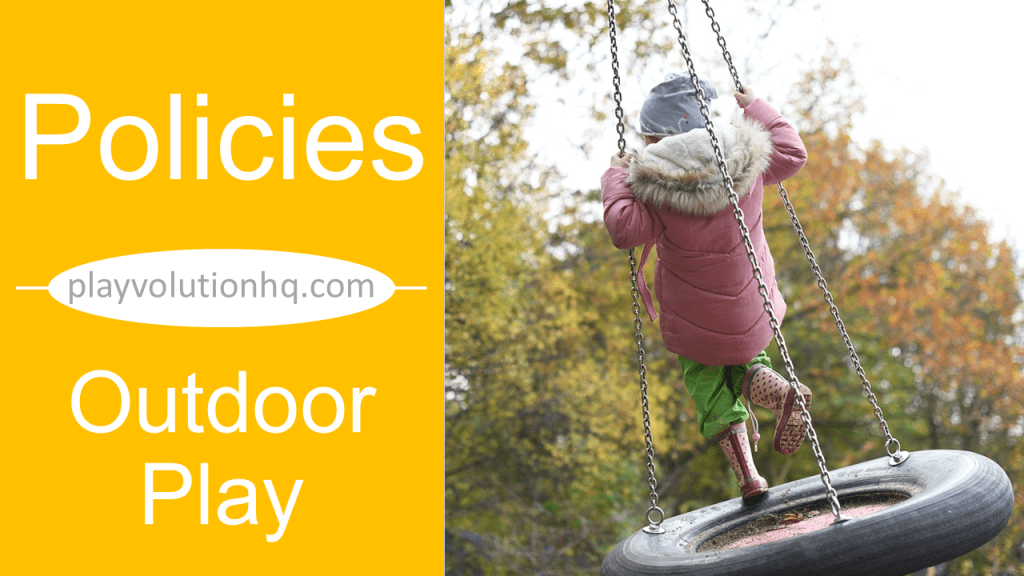
Table of Contents
Outdoor play is a cornerstone of play-focused early childhood education. It encompasses activities like running, climbing, exploring nature, and engaging in group games, all of which contribute to children’s physical, social, emotional, and cognitive development. These experiences allow children to connect with their environment, build physical skills, hone social skills, foster creativity, and more. A well-designed outdoor play policy ensures these activities are safe, engaging, and developmentally appropriate, providing a framework that benefits children, staff, and parents alike.
Purpose
Every play-based child care program should have a policy on outdoor play to guide its implementation and ensure consistency. This policy should:
- Ensure Safety—Establish clear guidelines to maintain a secure outdoor environment, reducing hazards while allowing exploration.
- Promote Physical Activity—Encourage regular outdoor time to enhance children’s health and physical development.
- Support Child Development—Align outdoor play with developmental goals, offering age-appropriate and inclusive opportunities.
- Provide Guidelines For Staff—Offer staff clear instructions on facilitating and supervising outdoor play effectively.
- Communicate With Parents—Inform families about the program’s commitment to outdoor play, including safety measures and expectations.
Where To Include
At Playvolution HQ, we recommend using the Three Handbook Method and adding this policy to your Operating Handbook.
Considerations
When crafting an outdoor play policy, consider these key factors:
- Parent Communication—Plan how to keep families informed about outdoor play policies, schedules, and any incidents.
- Weather Conditions—Define protocols for outdoor play during extreme heat, cold, rain, or other conditions, ensuring child safety and comfort.
- Supervision Ratios—Set appropriate staff-to-child ratios to maintain effective oversight during outdoor activities.
- Equipment Safety—Regular inspections and maintenance of outdoor play equipment are required to prevent injuries.
- Inclusivity—Design activities that are accessible and enjoyable for all children, including those with diverse abilities or needs.
- Educational Goals—Ensure outdoor play supports the program’s learning objectives, such as fostering curiosity or teamwork.
- Emergency Procedures—Outline steps for handling injuries or emergencies during outdoor play, including first aid and parent notification.
Real-World Policies
NOTE: The following samples are real-world examples relating to this post’s topic and are provided as a reference for creating your own policies and procedures. Sharing them here is not a recommendation of their content.
This post is intended to spark reflection and suggest ways of addressing the topic covered when writing or updating policies and procedures. Your policies and procedures should be written to meet your program’s needs and unique circumstances.
Browse More Policy & Procedure Resources Here
Example 1
Outdoor play is incorporated into the daily schedule for both the morning and afternoon. There is less structure in an
outdoor learning environment; however, staff members actively engage in activities when prompted by the children.
Outdoor play is an opportunity for children to run, jump, climb and use their bodies in ways that would otherwise be unsafe
in an indoor classroom. In addition, a large amount of social interaction takes place when children play outdoors. Because
they are engaged in fewer teacher-directed activities and more child-directed play, children are able to choose their friends
and who to interact with.
Children will go outside year-round, including winter. Only during extreme weather conditions will the children remain
indoors. Our teachers refer to the Child Care Weather Watch poster from the Iowa Department of Public Health to
determine if it is too hot or cold to play outdoors.
It is important for parents to send their children in appropriate clothing and outerwear for the weather conditions (e.g., coat,
snow pants, boots, gloves, etc.). Please clearly label all articles of clothing with your child’s name. LilyPad has a few
extra hats and mittens, but not enough for every child. If a child is not dressed appropriately for the weather, he or she may
have to remain inside. Please ask your child’s teacher if you have any questions about weather-appropriate clothing. (0060)
Example 2
All classrooms go outside daily (weather permitting). Your child will participate in outdoor activities unless we receive a doctor’s note stating the temporary need to stay indoors. A child that is not well enough to go outside daily is not well enough to attend care and should remain home. (0080)
Example 3
All children in full day child care centres are required to play outdoors for a minimum of two hours each day, weather permitting. During inclement weather, alternate active play must be provided indoors. Weather can change quickly. A rainy cool morning can rapidly become a humid, sunny afternoon. We ask that you always prepare your child for any type of weather so that your child can participate comfortably outdoors. (0116)
Example 4
All children partake in a variety of enriching outdoor experiences through our outdoor playground, gardens, splash pad, outdoor equipment and walks. (0032)
Sample Policy
This sample policy for the fictitious Playvolution Child Care Institute incorporates the above considerations and uses our recommended 5 policy headings. It is only intended as a guideline. Your policy and procedures relating to this topic should be unique to your program.
Purpose
The purpose of this policy is to ensure that outdoor play at Playvolution Child Care Institute is a safe, enriching, and integral part of our play-based curriculum.
Policy
We prioritize outdoor play as a daily component of our program. We provide a safe, stimulating outdoor space where children can explore, learn, and thrive during self-directed play and exploration.
Procedures
We institute the above policy as follows:
- Schedule Daily Outdoor Play—Children will engage in at least 60 minutes of outdoor play daily. Longer outdoor play periods will be provided whenever possible.
- Conduct Safety Checks—Staff will inspect outdoor areas and equipment daily before use to confirm safety and functionality.
- Supervision—Staff will actively supervise outdoor play to ensure safety without interfering with children’s self-directed play and exploration.
- Adapt To Weather Conditions—Staff and children will dress appropriately for the weather conditions. Outdoor play time may be curtailed or canceled in cases of extreme weather, such as temperatures below -10°F (-23°C), above 95°F (35°C), intense rain, thunderstorms, or winds exceeding 25 mph (40 kph)
Notes
Here are related resources:
- Risk And Adventure In Early Years Outdoor Play
- Balanced And Barefoot: How Unrestricted Outdoor Play Makes for Strong, Confident, and Capable Children
- Let ‘Em Out! The Many Benefits of Outdoor Play In Kindergarten
- How nature play can fix kids’ obsession with screens
- Scientists Claim Time On The Playground Is More Beneficial Than Time In The Classroom
- Free Forms | Risky Play Observation Form
Tracking
CI-2.3 V-1.0 Approved by the Executive Committee effective 03/14/2025
Brought to you by Explorations Early Learning
Contribute content to Playvolution HQ
Related Content


Browse Trainings
Author
Jeff Johnson is an early learning trainer, podcaster, and author who founded Explorations Early Learning, Playvolution HQ, and Play Haven.
In-Person And Online Training
Learn how to book an in-person or online training for your organization on these early learning topics.
Support The Site
I participate in the Amazon Services LLC Associates Program, an affiliate advertising program designed to provide a means for me to earn fees
by linking to Amazon.com and affiliate sites.
Thanks To Our Patrons
This post was made possible by patrons like these, who generously fund our work:
Supporters
Lissadell Greene Stephanie Goloway Jennifer Stark
Lagina Kozak Michelle Hankins
Marie Messinger Tamara L. Lakin
Fans
Jen Flemming Lizz Nolasco Cynthia J Bays
Susan Warner Kelly Sigalove Shawn Wolf
Vittoria Jimerson Codee Gilbert Wendy Tedford
Monica Morrell Pam Soloman Melissa Franklin
Teresa Watson Erika Felt Autumn Peele
Melissa Taylor Jahmeela Robinson Stacie Manning
Amber Maurina Terra Calamari Anne Jackson
Lagina Kozak Samantha Yeager-Cheevers
Elizebeth McCoy Sammy Cousens Ellen Cogan


Leave a Reply